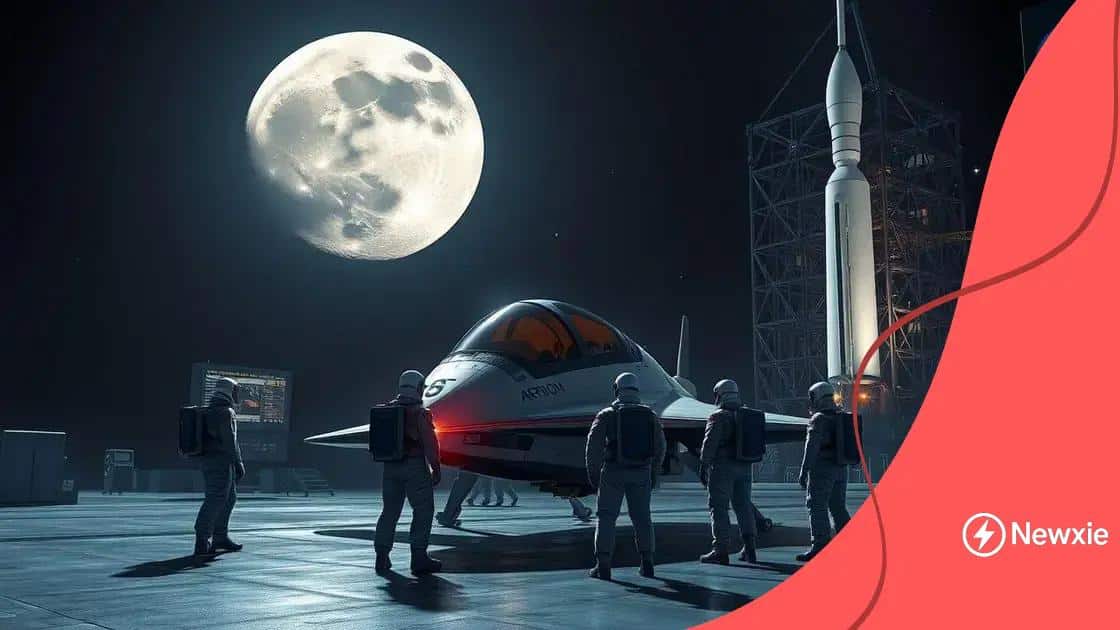NASA Artemis program updates: what’s next for lunar exploration

Anúncios
The NASA Artemis program aims to return humans to the Moon and develop sustainable exploration technologies that will serve as a foundation for future Mars missions, fostering international collaboration and inspiring the next generation of scientists and engineers.
NASA Artemis program updates are constantly reshaping our understanding of lunar exploration. Curious about what’s next? Let’s dive into the latest developments and what they mean for future missions.
Anúncios
Overview of the NASA Artemis program
The NASA Artemis program is a groundbreaking initiative aimed at returning humans to the Moon and establishing a sustainable presence there. It marks a pivotal step in space exploration, setting the stage for future journeys to Mars and beyond. The program aims to land the first woman and the next man on the lunar surface, showcasing NASA’s commitment to diversity in space exploration.
As part of the Artemis program, several key missions are planned. The first mission, Artemis I, is an uncrewed test flight that will go around the Moon. This mission is crucial for testing the Space Launch System (SLS) and the Orion spacecraft, helping ensure the safety of future crewed missions.
Key Features of the Artemis Program
This program includes several innovative features designed to enhance lunar exploration:
Anúncios
- Human landing system: The Artemis program will utilize advanced technology for safe lunar landings.
- Lunar Gateway: A space station orbiting the Moon will support deep-space missions.
- International collaboration: NASA partners with other countries and organizations to enhance mission capabilities.
Each Artemis mission builds on the success of previous missions, using lessons learned to refine techniques and technologies. The program’s vision extends to creating a long-term human presence on the Moon, fostering scientific research that can benefit all of humanity.
As we explore the NASA Artemis program, it’s clear that the ambitions stretch far beyond mere lunar landings. They aim to establish a base for deeper space exploration, paving the way for missions to Mars. This initiative not only seeks to enhance our understanding of the Moon but also aims to inspire future generations of explorers.
Key milestones achieved in 2023
In 2023, the NASA Artemis program reached several significant milestones, paving the way for future lunar exploration. These achievements showcase NASA’s innovative efforts and commitment to advancing space travel.
One of the most notable milestones was the successful launch of the Artemis I mission. This uncrewed test flight marked a historic moment, as it validated the capabilities of the Space Launch System (SLS) and the Orion spacecraft. During this mission, Orion traveled to the Moon and returned safely, providing critical data for crewed missions.
Highlights of the Year
The following are key highlights from 2023 that demonstrate the progress made:
- Testing and technology: Rigorous testing ensured that all systems were ready for crewed missions.
- Partnerships: New international partnerships were established, enhancing collaboration for lunar missions.
- Public engagement: NASA launched educational initiatives to inspire the next generation of explorers.
Another achievement was the development of the Lunar Gateway. This orbiting space station will support long-term lunar exploration and serve as a hub for future missions to Mars. Its design incorporates sustainable technologies, which reflect NASA’s vision for a lasting human presence on the Moon.
The Artemis program in 2023 has not only set the stage for lunar exploration but also inspired public interest in space. Events showcasing the Artemis missions and their goals have motivated young people to consider careers in science, technology, engineering, and mathematics (STEM).
Upcoming missions and objectives

The future of the NASA Artemis program is bright, with exciting upcoming missions and objectives set to take humanity further into space. These missions aim to build on past achievements and open new frontiers in lunar exploration.
The next planned mission, Artemis II, marks a significant milestone as it will be the first crewed flight of the Orion spacecraft. This mission will elevate the Artemis program, allowing astronauts to orbit the Moon and gather crucial data for future lunar missions. The crew will also conduct testing on life support systems necessary for long-duration space travel.
Key Objectives for Artemis Missions
Each upcoming mission has clear goals designed to further our understanding of the Moon and prepare for future exploration:
- Landing on the South Pole: Artemis III aims to land astronauts at the lunar South Pole, a region rich in water ice.
- Establishing a lunar base: The program plans to develop a sustainable human presence, paving the way for research and extended stays on the Moon.
- Science and research: Missions will pursue scientific inquiries, such as studying lunar geology and the effects of long-term space travel on the human body.
After establishing a foothold on the Moon, future missions will focus on Mars. Artemis serves as a stepping stone, utilizing technology and experience gained from lunar missions to facilitate exploration of the Red Planet.
The collaboration with international partners will play a crucial role in the success of these missions, fostering a spirit of unity in space exploration. Through joint efforts, NASA aims to utilize diverse expertise and resources to enhance mission outcomes and capabilities, thereby inspiring future generations.
International collaboration in lunar exploration
International collaboration is a cornerstone of the NASA Artemis program, showcasing unity in the quest for lunar exploration. Various countries and organizations are joining forces to support missions to the Moon, fostering a global approach to space science.
One significant aspect of this collaboration is the establishment of the Lunar Gateway. This orbital platform will serve as a staging point for lunar missions and is being developed with contributions from several space agencies, including the European Space Agency (ESA) and the Japan Aerospace Exploration Agency (JAXA). The Gateway is set to facilitate international science experiments and technology demonstrations.
Key Partnerships
Collaboration with international partners brings many advantages:
- Diverse expertise: Partnering with different countries allows access to unique technologies and knowledge.
- Shared resources: Pooling financial and material resources helps reduce costs and increase mission capabilities.
- Broader scientific research: Together, agencies can conduct complex experiments that benefit humanity as a whole.
In addition to governmental collaborations, private companies from various countries are also joining the effort. By leveraging commercial space technologies, NASA can focus on key mission goals while the private sector handles certain logistical aspects. This partnership creates a vibrant ecosystem that drives innovation and increases efficiency in space exploration.
As the Artemis program continues to evolve, the importance of international cooperation will only grow. With the shared goal of pushing the boundaries of human exploration, these collaborations not only enhance lunar missions but also lay the groundwork for future endeavors, such as Mars exploration.
Impact of Artemis on future space travel
The NASA Artemis program is set to significantly impact future space travel, shaping how humanity explores beyond Earth. By returning to the Moon, Artemis will provide valuable insights and technologies that will pave the way for deeper space missions.
One key aspect of Artemis is its innovative approach to sustainable lunar exploration. By establishing a permanent human presence on the Moon, NASA aims to develop technologies that ensure long-term habitation. This includes advancements in life support systems, building materials, and energy sources, all of which will be vital for missions to Mars.
Technological Advancements
As part of the Artemis program, new technologies will be developed and tested, enhancing our capabilities in space. Some expected advancements include:
- Reusable spacecraft: Innovations in spacecraft design will allow for reusable vehicles, reducing costs significantly.
- Advanced propulsion systems: Developing new propulsion technology will enable faster travel to distant destinations.
- In-situ resource utilization: The capability to use lunar materials for fuel and building will reduce the need to transport resources from Earth.
Another impact of the Artemis program is the promotion of international cooperation in space. The program emphasizes partnerships with various countries, enhancing collective knowledge and resources. This global approach not only strengthens mission success but also fosters goodwill among nations, highlighting the collaborative spirit of space exploration.
Moreover, Artemis will inspire a new generation of scientists and engineers. By showcasing the possibilities of space exploration, the program will attract young people into science, technology, engineering, and mathematics (STEM) fields. As students see the tangible results of space missions, their interest in these areas will grow, helping to build a skilled workforce for future endeavors.
FAQ – Frequently Asked Questions about the NASA Artemis Program
What is the main goal of the Artemis program?
The main goal of the Artemis program is to return humans to the Moon and establish a sustainable presence there, paving the way for future exploration of Mars.
How does international collaboration benefit the Artemis program?
International collaboration brings diverse expertise and resources, enhancing mission capabilities and fostering goodwill among participating countries.
What technological advancements can we expect from Artemis?
Artemis is expected to develop new technologies such as reusable spacecraft, advanced propulsion systems, and in-situ resource utilization for sustainable lunar exploration.
How will Artemis inspire future generations?
By highlighting the possibilities of space exploration, Artemis will attract young people to STEM fields, encouraging the next generation of scientists and engineers.
SEE MORE CONTENT





